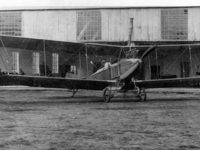The AEG B.I was a military version of the civil aircraft AEG Z6 and the first aircraft of the company, which was produced for the new flying force of the German Empire.
Development and construction:
As the continuous development of an air force continued in the German Empire, military aircraft were presented by various companies.
The civil aircraft AEG Z6 was one of the first biplane aircraft, but was initially used only for civilian operation. The company AEG, however, modified the model something with which it could be used as a reconnaissance and training aircraft by the military.
Striking was the construction of welded steel pipe, which was carried out not only in the fuselage but also in the wings of the aircraft. Was also installed a 100hp strong inline engine, which, however, limited by its high seat aerodynamics.
Under the engine was an additional wheel, which should prevent a landslide.
Use in the First World War:
With the outbreak of the First World War, the unarmed aircraft were used exclusively for reconnaissance flights and as a training aircraft. After a short time the types B.I were replaced by the B.II and B.III types.
Technical specifications:
| Designation: | AEG B.I |
| Country: | German Empire |
| Typ: | Reconnaissance aircraft, trainer aircraft |
| Length: | 10,5 Meter |
| Span: | 14,5 Meter |
| Height: | unknown |
| Mass: | 744 kg empty |
| Crew: | Max. 2 |
| Engine: | Water-cooled inline 6-cylinder engine Benz FX (Bz II) or Mercedes D I 100PS |
| Maximum speed: | 110 km/h |
| Reach: | unknown |
| Armament: | none |
You can find the right literature here:
Fokker Dr I Aces of World War 1 (Aircraft of the Aces)
Undoubtedly the most famous fighter type to see service on either side during World War 1, the Fokker Dr I was a revelation when it entered service on the western front in 1917. Manfred von Richthofens JG 1 circus was the first Jasta to completely re-equip with the new fighter, and in the skilled hands of its numerous aces the Dr I proved a formidable opponent. The Dr I remained in service on the Western Front until replaced by the superior Fokker D VII in May 1918. Just weeks prior to that, however, Germanys leading ace, the great Red Baron, had been killed at the controls of a Dr I.
Friedrichshafen Aircraft of WWI: A Centennial Perspective on Great War Airplanes (Great War Aviation) (Volume 21)

Friedrichshafen Aircraft of WWI: A Centennial Perspective on Great War Airplanes (Great War Aviation) (Volume 21) Paperback – February 16, 2016
This book describes and illustrates the development of Friedrichshafen aircraft of WWI with text, 540 photos, 18 in color, 37 color profiles, production quantities and serial numbers of aircraft, and aircraft dimensions and performance specifications. In addition, there are 26 official SVK drawings and 11 aircraft are illustrated in scale drawings to 1/48 (4) or 1/72 (7) scales. The book has 312 pages and is of interest to aviation historians, enthusiasts, and modelers alike.
German and Austro-Hungarian Aircraft Manufacturers 1908-1918
Much has been written about the British aircraft of the First World War, but little has surfaced about the aircraft of the Axis powers, Germany and Austria. Here, Terry C. Treadwell tells the story of the aircraft from companies such as Fokker, builder of the famous triplane, as fl own by Baron von Richthofen's Flying Circus, AEG, Albatros, Junkers and Hansa. From reconnaissance aircraft to state-of-the-art bombers that could reach London, this is the definitive guide to aircraft of the Axis powers during the First World War. The aircraft are explained in detail and a history of each company is provided, making this an excellent source book for aircraft enthusiasts, model makers and those interested in the air war over the trenches of France and Belgium, as well as further afield in the Italian campaign.
The Zeppelin in Combat: A History of the German Naval Airship Division
The standard reference now revised and expanded. Dr. Robinson has opened up his vast photo archives to enhance this new edition of his classic work. Much of the new photographic material is published here for the first time.
This post is also available in:
 Deutsch (German)
Deutsch (German)  Français (French)
Français (French)  Italiano (Italian)
Italiano (Italian)  简体中文 (Chinese (Simplified))
简体中文 (Chinese (Simplified))  Русский (Russian)
Русский (Russian)  Español (Spanish)
Español (Spanish)  العربية (Arabic)
العربية (Arabic)















